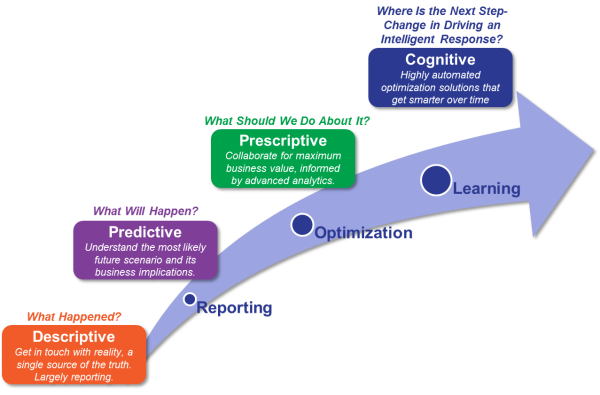There is a general consensus among analysts that businesses organized around industrial age principles need to transform into digital enterprises if they are going to survive and thrive in the decades ahead. Part of that digital transformation involves supply chain operations. Lora Cecere (@lcecere), founder and President of Supply Chain Insights, notes, “Today the term [digital transformation] lacks a common meaning.”[1] She says when she asks subject matter experts to define digital transformation they often use terms such as:
1. Autonomous Supply Chain: Meaning “automation of supply chain processes through cognitive learning and artificial intelligence eliminating labor and reducing the need for people to touch data.”
2. Value Chain Uberization: Meaning “a platform to enable shared resources across a community.”
3. 3D Printing: Meaning “localization of manufacturing through the sharing of digital images using additive manufacturing.”
4. Internet of Things: Meaning “the use of machine-to-machine streaming data to improve supply chain outcomes.”
5. Multi-Tier Networks and Redefinition of B2B: Meaning, “the building and execution of multi-tier networks for data sharing, collaborative workflows, and improved decision making. This includes a discussion of blockchain, network canonicals, and interoperability.”
6. Cloud-Based Computing: “The promise of cloud is [the] federation and democratization of data, in both private and public clouds, with the promise of lower cost of ownership.”
7. Listening: Meaning, “the use of unstructured data — social sentiment, warranty, and quality data — to improve organizational productivity and align processes outside-in to be market-driven. Market-driven is a more mature definition of demand-driven.”
She concludes, “For me, it is not one concept, but a convergence.” Cecere is not alone in asserting that no universally accepted definition of digital transformation or digital supply chain exists. Antoine Rizk (@Antoine_Rizk1), Vice President for Go-To-Market Programs, B2B and API at Axway, writes, “The term digital supply chain is not new. Tony Hines coined it back in 2001, long before the ‘digital’ trend. Originally, Hines intended it to mean simply the supply chain of non-physical goods, such as music and e-books, as opposed to physical goods such as car parts or apparel.”[2] Rizk goes on to note, “Digital is about changing how business works, through the adoption of digital platforms — cloud, big data, mobility and social media. It is therefore not only about making new services accessible via mobiles in order to address new markets, and even less about automating a what was once a manual process. Digital transformation is about making the enterprise more successful and competitive, more agile and closer to the customers thanks to the digital platforms.”
The Digital Supply Chain and Technological Convergence
Cecere is correct that digital transformation is more of a perfect storm of converging technologies than it is a cohesive concept. In the digital age, one-size-fits-all strategies don’t work. Industries are unique and so are the businesses within industries. Each business must work out for itself what it means to become a digital enterprise. Rizk explains, “This implies that the enterprise: Adapts its business model and organization to be open to multiple distribution channels; [and] is always ready to meet new customer expectations — agile deployment of new services, and a new customer experience. This creates new challenges for the supply chain: Management of new interaction patterns, and new interaction channels with an ever increasing number of providers and consumers; [and the] ability to operate securely and in a controlled manner, within an information space that extends to the entire ecosystem of partners, and even competitors.” Connectivity is what allows technological convergence to take place. Rizk explains:
“According to TechTarget, a true digital supply chain fully capitalizes on connectivity, system integration and the information-producing capabilities of ‘smart’ components. The ultimate goal of the digital supply chain is to enable insights for increased efficiencies, doing away with waste and facilitating greater profits. Companies with a digital supply chain are better able to move resources, assets, people and inventory to where they are needed at any given time in order to reduce costs by responding proactively to transportation and manufacturing risks. The potential payoffs of a fully realized digital supply chain include savings in every area, from resources, time, and money to a reduced environmental footprint.”
The most important component of the “smart components” to which Rizk refers is cognitive computing. Cognitive computing platforms take full advantage of connectivity with their ability to gather, integrate, and analyze both structured and unstructured data. Pierfrancesco Manenti (@PierManenti), Vice President for Research at SCM World, indicates a recent survey found “47% of supply chain leaders from our larger community believe that artificial intelligence is disruptive and important with respect to supply chain strategies.”[3] He adds, “Business activities that require to collect and analyze lots of structured and unstructured data can benefit from artificial intelligence and its ability to support faster and smarter decision making. Supply chain is therefore a natural fit for artificial intelligence.”
The Digital Supply Chain Moves from the Periphery to the Center
For years now, Cecere has insisted, “The supply chain IS Business, not a department within a business.”[4] That statement is even truer today than it was when she wrote it four years ago. Carlos Cordon, LEGO Professor of Strategy and Supply Chain Management at IMD, agrees with Cecere. He writes, “Experts would usually claim that supply chain management is about delivering the right quality at the lowest cost, with the agreed service level, right? Well, not anymore. … It is also about increasing sales and profits; the supply chain is no longer just about efficiency, working capital reduction and inventory management.”[5] He continues:
“Executives have always known that improving supply chains ultimately improves sales. However, because the impact was very difficult to evaluate, companies traditionally approved investments in supply chains based only on the expected reductions in costs and working capital. The digitalization of supply chains, with the breadth of sales and ordering data available, now makes it possible to calculate by how much supply chain improvements are increasing sales and profits, and the numbers are often amazing.”
Rizk explains that a digital supply chain, leveraging cognitive technologies, can make any business better. He writes:
“According to Accenture, a digital supply chain is connected, intelligent, scalable, and rapid. Connected is the foundation, leveraging various digital capabilities for extensive visibility, outsized influence and high levels of control. Moreover connected companies interact more fully with the entire business ecosystem. Often in real time, they can react, relate and communicate more completely with customers—diagnosing the latters’ needs and involving them in product planning and design initiatives. Business benefits from connectivity are improved planning, execution and collaboration. Connectivity also allows more data to be captured, resulting in actionable intelligence, proactive decision making, and advanced data analytics to better meet customer expectations.”
The ability to turn data into actionable intelligence is why cognitive technologies are moving the supply chain from the periphery to the center. Cecere notes, “The most advanced work on AI is at IBM, SAS labs, and pilot work by Enterra Solutions, and FusionOps.” In the following graphic, she shows how the analysis of data has moved from looking at the past to predicting the future.

Summary
Cordon concludes, “We should start to use the term Value Chain 4.0, because we might need to re-combine and re-think how we work and organize companies. The key is how to generate and capture value in the whole chain. And it looks very different from the past.” How different? Manenti explains, “The awareness and ability to make fact-based decisions that artificial intelligence makes possible is completely new to supply chain management. This technology is expected to create the sentient supply chain of the future — able to feel, perceive and react to situations at an extraordinarily granular level. Welcome to the future!”
Footnotes
[1] Lora Cecere, “Are You Active in the Digital Transformation Drinking Game?” Supply Chain Shaman, 7 March 2017.
[2] Antoine Rizk, “What is Digital Supply Chain?” Integration and Analytics in Supply Chain, 27 January 2017.
[3] Pierfrancesco Manenti, “Artificial Intelligence and Future Supply Chains,” Supply Chain Digital, 7 February 2017.
[4] Lora Cecere, “Sage advice? Only for turkeys.” eft, 1 February 2013.
[5] Carlos Cordon, “,” Supply Chain Movement, 15 February 2017.





